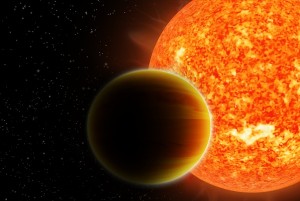main content begins
Before the 1990s, no planets were known to exist outside our Solar System. Then in 1992, two extra-solar planets, or exoplanets, were discovered in orbit around a distant pulsar.
Astronomers made this and other early exoplanet discoveries by observing the motion of stars. As exoplanets orbit stars, their gravitational influence causes the stars to move. From this motion, astronomers infer the existence of the orbiting body.
Other exoplanets were discovered by imaging them directly—an immense challenge given that a typical planet is a billionth as bright as the star it orbits, and is hidden in the glare of its parent. It’s like looking for a firefly in the light of a giant spotlight.
Astronomers also find exoplanets by observing a slight, short-lived decrease in a star’s brightness, which repeats at a precise interval. This periodic dimming is caused by a transit—a planet passing between the star and the observer.
The Kepler spacecraft monitors some 150,000 Sun-like stars looking for planetary transits and it has been spectacularly successful. As of the end of the mission in 2014, Kepler has identified more than 1000 exoplanets and nearly 4000 planetary candidates.
An extended mission using the Kepler spacecraft, K2, continues to observe stars on the elliptical plane, a much larger area of the sky. Dunlap scientists analyze Kepler and K2 data to discover transiting exoplanets, and study the properties and population statistic with these discoveries.
Astronomers at the Dunlap Institute made transit observations with Arctic Wide-field Cameras (AWCams) at the PEARL science station on Ellesmere Island in the winter of 2012/13. Data gathered are expected to reveal new exoplanets.
Dunlap astronomers are also members of the Gemini Planet Imager team. GPI is a direct-imaging instrument commissioned at the Gemini South observatory in late 2013. Once testing of GPI is completed in 2014, Jérome Maire and Max Millar-Blanchaer will be part of the team conducting the GPI Exoplanet Survey (GPIES) and analyzing new data. The survey will run through 2017, targeting some 600 stars.

Illustration of a ‘hot Jupiter’ orbiting a sun-like star. Image: Haven Giguere, Nikku Madhusudhan
At the Dunlap Institute: